You are currently browsing the tag archive for the ‘Margaret Stratton’ tag.
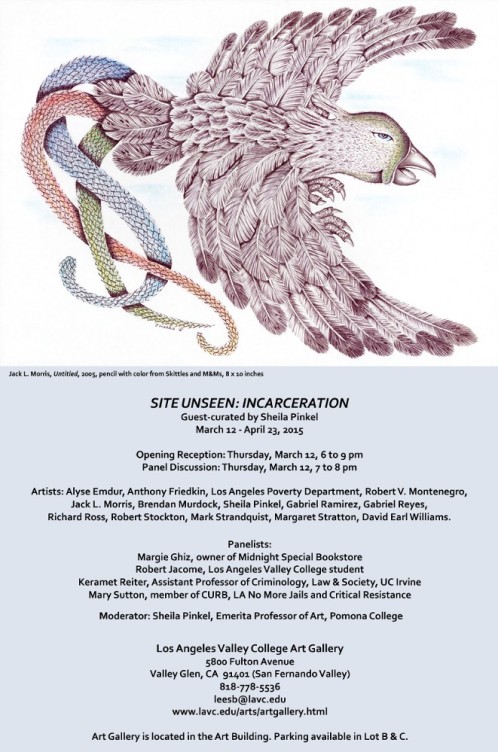
Site Unseen: Incarceration flyer. Featuring the work of Jack L. Morris, a California prisoner who has been in solitary confinement for almost 25 years.
Do artworks made on opposite sides of prison walls work together in a gallery space?
Yesterday, at the Los Angeles Valley College, in Valley Glen, CA the exhibition Site Unseen: Incarceration came down form the walls. It was an exhibition bringing together prisoner-made art with artworks made by outside artists about prisons. (Catalogue in PDF, here)
Some artists I knew — Alyse Emdur, Anthony Friedkin, Los Angeles Poverty Department, Sheila Pinkel, Richard Ross, Mark Strandquist, and Margaret Stratton. Others are new to me — Robert V. Montenegro, Jack L. Morris, Brendan Murdock, Gabriel Ramirez, Gabriel Reyes, Robert Stockton and David Earl Williams.
Shamefully, all those names with which I am unfamiliar I quickly learnt are prisoners. Why shame? Well, it’s all about consistency. I value activism that is built upon close alliance with, and information, from prisoners. There are no better experts on the system than those subject to it. At the very least, I should know and support the leading Prison Artists.
However, when it comes to painting and illustration, I have adopted lazy double standards. Without examination, I have demoted prisoner made art — commonly referred to by the catch all “Prison Art” — to an inferior status. I have prejudged most Prison Art. For my own comfort, I have bracketed Prison Art as naive and limited. I’ve conveniently focused on scarcity of supplies inside prison of prison to cursorily explain the lo-fi aesthetic of Prison Art.
My “logic” blinded me to the invention, resourcefulness and resistance inherent to almost all prison art. Hell, we’ve got prisoners making work out of M&Ms.
Site Unseen: Incarceration, therefore, is a nice kick back in the right direction. If we don’t have prisoners’ own artwork upon which to meditate then we lose site of the issues fast. As much as I have championed the work of Emdur, Ross, Strandquist and the Los Angeles Poverty Department, I want to now celebrate the works of Jack L. Morris, Brendan Murdock, Gabriel Ramirez, Gabriel Reyes and David Earl Williams.
I wish also to applaud Sheila Pinkel for bringing together inside and outside, and for committing the oppressed and their allies to one another upon gallery walls.
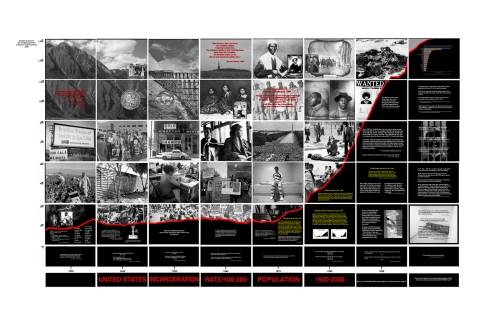
Sheila Pinkel. Site Unseen: U.S. Incarceration (2014). 7’ x 14’ Archival ink jet prints. Pinkel remarks, “Site Unseen: U.S. Incarceration includes the major laws that have resulted in the expansion of the prison system, the Sentencing Reform Act (1984), Mandatory Minimum Sentencing Law (1986) and Three Strikes Law (1994). It is important to note that in the 1960s, during the civil rights era, rate of incarceration was declining as people adopted the ‘rehabilitation not incarceration’ attitude. However, after the Rockefeller Drug Laws took hold, incarceration in the United States began to grow exponentially. Also included is demographic information about the high rate of incarceration of non-white people and women, the great number of people being held in solitary confinement and the massive amounts of money being made by investors in the prison industrial complex. The backdrop for the graph is a set of images from U.S. history taken in the 19th and 20th centuries that reflect the treatment of minorities and prisoners. The poor, non-white and uneducated make up the majority of incarcerated today.
Origins of the Show
In 2004, Pinkel exhibited for the first time her mammoth work Site Unseen: U.S. Incarceration (above). While the shared title between this catalyst work and the exhibition confuses matters a little, it demonstrates the degree to which Pinkel is bound to prison reform. Passion + politics is usually a good recipe for art.
Pinkel’s motivations for mounting the show are many — concerns for Mumia Abu-Jamal’s case; an awareness of slavery (past and present); the doctrines of ownership and manifest destiny; sensitivity to the quiet traditions of aboriginal people; a raised consciousness toward the unparalleled use of torturous solitary confinement; and the profit making industries of the prison industrial complex; and more besides.
The urgent issues within the reform and abolitionist movements are so great that often they can drown each other out, or obscure one another. Perhaps, that is where silent 2D artworks come to play their part. Perhaps, a gallery space in which viewers can mediate their own responses is a hushed but vital contribution to the reform debate?
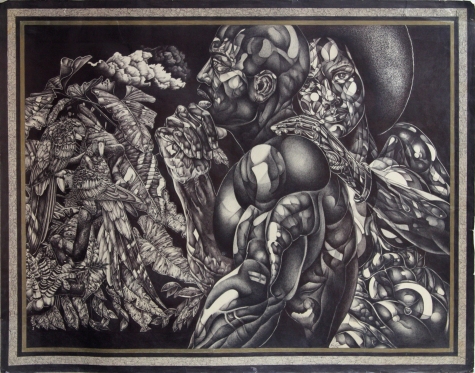
David Earl Williams. Parrots (1996). 22” x 28” Ball point pen.
It is helpful for me to interrogate the idea that gallery shows and art have an effect upon political realities. I make a conscious effort to justify my workand others’ and to continually ask if analysing images and creative output from prisons changes the daily experience of the United States’ 2.3 million prisoners.
I conclude, often, that conscientious and intellectually honest analysis of images from prisons plays its role in the wider discussion needed to drag us out of this prison crisis.
Prison Sketches in the Absence of Prison Photos
Undoubtedly, in the past few years, solitary confinement has emerged as one of the main, digestible and terrifying issues behind which reformers could win arguments, gain traction and mindshare. The public now know that 80,000 people on any given day are subject to psychological torture within our prisons.
Many of the photographs of Supermax and solitary units — and there are not many — have come about because of court ordered entry to facilities. With the exception of Social Practice make-believe, artists and photographers have, for the most part, failed to image these dark, hidden spaces for the public. I’m apportioning no blame here, just pointing out fact. With that understanding, then, it is significant that the majority of prison artists in Site Unseen are either in solitary or on death row.
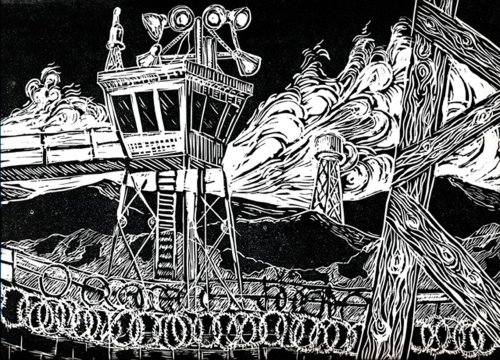
Brendan Murdock. Tower (2012). 9” x 12” Linoleum cut print.
One of the artists in Site Unseen is Jack L. Morris, a creative spirit with whom Pinkel has had a lasting personal and professional relationship. In 2011, Pinkel began corresponding with Morris. At that point, he’d been incarcerated for 31 years. In 1978, aged 18, Morris was sentenced to a 15 years to life for being an accomplice to a murder. When the California Department of Corrections (CDCr) opened Pelican Bay Sate Prison (the first state-run Supermax in the nation) in 1989, Morris was transferred. He’s been in solitary confinement since.
“During this time he has not seen sunlight or touched another person,” says Pinkel.
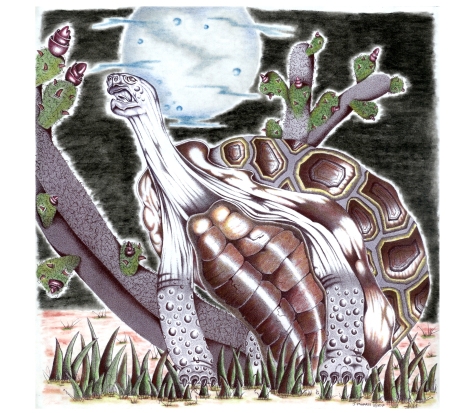
Jack L. Morris. Turtle (2012). Dimensions: 12” x 12” Medium: pen, pencil, peanut butter oil, pastel color.
Pinkel points out that the decision-making power to place someone in solitary is solely in the hands of the correctional officers. Checks and balances against abuse in this ‘Us vs. Them’ equation are largely absent. Pinkel believes that Morris, like many prisoners in the SHU, is subject to a Kafkaesque situation in which solitary is inescapable. While policies are shifting after attention from Sacramento politicians, it remains incredibly difficult to get out of the SHU if CDCr has classed you as a gang member.
“Jack has not been involved in gang activity and has had no ability to be involved in it since he has been in solitary. However, he is repeatedly denied release from solitary and has had his designation increased to active gang affiliation,” says Pinkel. “At the moment, there is no legal way for him to get out and, to my mind, there is no good being served by his continued incarceration, either in solitary or in prison at all.”
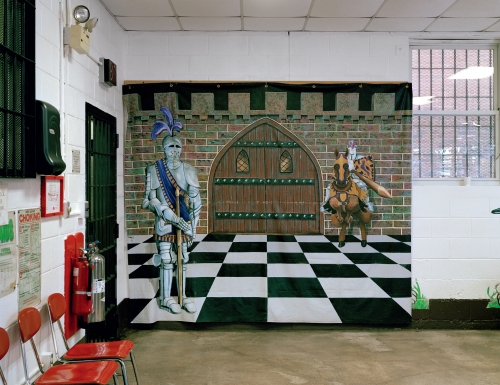
Alyse Emdur. Anonymous backdrop painted in New York State Correctional Facility Woodburn (2012). Dimensions:42” x 52” Inkjet print.
Clearly, Pinkel has an affiliation. Put that aside though and consider Morris for his work and you can’t help but be impressed. In order to prevent himself “losing his mind”, Morris created poems, drawing and letters. Pinkel published them in the book The World of Jack L. Morris: From the SHU.
“Together,” says Pinkel, “they form a complex picture of a talented person who believed most of his life that he was not intelligent.”
And so we arrive here. At Morris’ and other art from inside. To be mesmerised by the intricacy of the work is understandable, but more-so we should be quietly and slowly scrutinising the work and using it as a gateway to a psychology we must surely hope we, or any of our loved ones, ever come to know.
Prison illustrations work very similarly to photographs in some ways, in that tropes recur and we find ourselves glossing over them. We presume that the system gives rise to them same type of images of flora, fauna, cars, tattoo-inspired designs, versions of women, motorcycles, sad clowns, tears and blood. These things are prevalent, but individual touches exist in the gaps and it is there we may identify the individual artist.
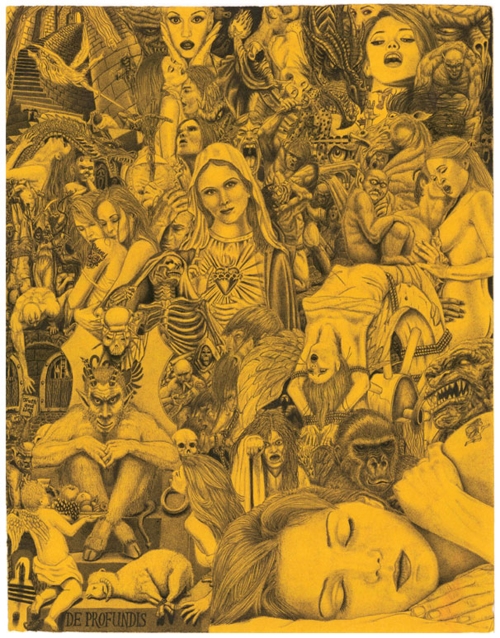
Gabriel Ramirez. De Profundis … Dreams (Before 2007). 11.5” x 15” Medium: Pencil on manilla envelope.
The worst thing prison art and photography, alike, can be is misunderstood as aesthetic cliche and used as excuse to bypass the social conditions from which they arise. Prisoner art from solitary is the most reliable source of imagery on which we can rely to learn about extreme confinement. We just need to give it space to percolate. A gallery can do that.
There’s a perverse clash of time appreciation at work in order for prison art to have an effect. The artist labors for days and weeks on a single piece and goes to great lengths to deliver it outside the institution. On the outside, we’re spoilt for images and it’s almost luck or strange happenstance for us to spend more than a few seconds with an image. But, it is possible and a gallery can do that.
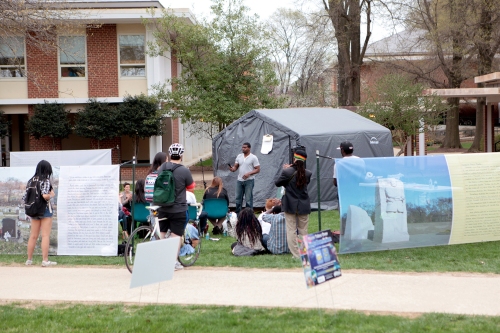
Mark Strandquist. Windows From Prison (2014). Banners 5’ x 11’. Digital prints on vinyl.
Strange Brew
As might evident, I am largely in support of Site Unseen. However, looking over the catalogue, I am a bit skeptical toward the mix of works. Does Mark Strandquist’s work (above) that relies heavily on public education and engagement work when he cannot transform the gallery into a workshop space or collaborate with local reform groups? Are we getting to the point that a prison show cannot exist without the work of Richard Ross!? (I’m friends with Richard and had breakfast with him this morning; he won’t mind the snark). It just seems Ross might be an easy option.
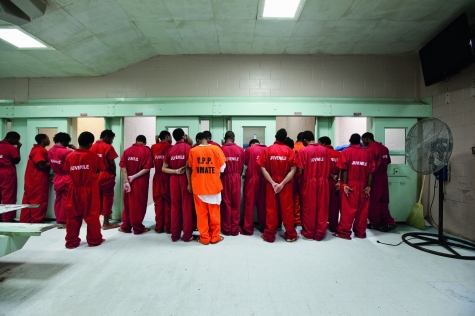
Is Site Unseen a prison art show supported by outside sympathisers, some of whom happen to be artists? Or is it a genuine attempt to level the field and present artists inside and outside as equivalents? The latter is a tough proposition. I have seen it done though. The Cell and the Sanctuary (Santa Cruz Museum of Art & History) managed to knit insider and outsider artists works together, but they managed it effectively because they were all either students or faculty in the William James Association’s Arts In Corrections program at San Quentin. A visual thread ran through The Cell and the Sanctuary that is not as immediately apparent in Site Unseen.
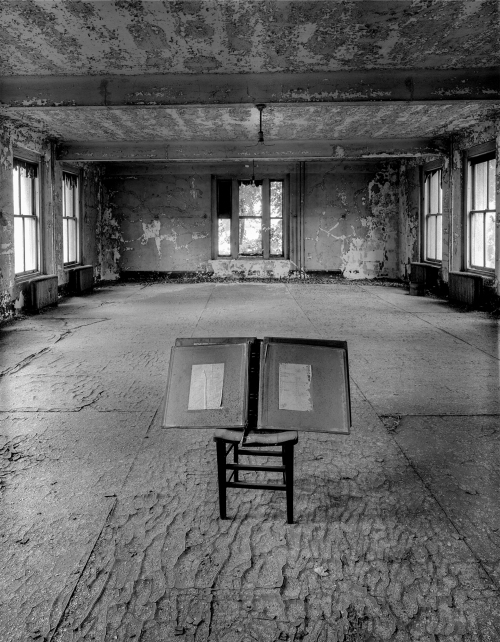
Margaret Stratton. Ship’s Passenger Log, December 1916, Ellis Island, New York City, June 29, 1999, 10:35 a.m. (1999). 16” x 20”. Archival digital print.
The main culprit, for me, is the work of Margaret Stratton (above). I’ve constantly wondered what use have images of decaying/ abandoned prisons for connecting us to pressing contemporary prison issues. I can find value in most other works in Site Unseen as they’ve a clear umbilical cord to the tumorous, pulsing Prison Industrial Complex. We can sense the toxic bile of the system in the majority of the works. We can wonder at the ability to stay sane and creative from within such a system. I get none of that awe from Stratton’s work.
I understand Stratton’s B&W images employ a different route to the issue and I don’t want to suggest there’s any inherent flaw in the work or its tactics. The fault, if any, lies with the decision to include this type of work that I identify as an outlier within the collected works.
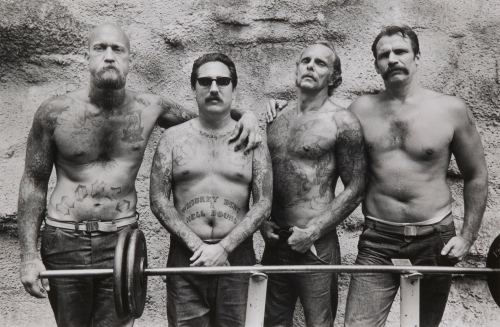
Four Convicts, Folsom Prison, CA (1991). Dimensions: 11” x 14” Black and white gelatin silver print.
Another , but slightly less obvious, outlier is Anthony Friedkin’s photo of four Folsom prisoners in the early 90s. It is a captivating portrait for sure (one that I featured very early on Prison Photography) but it is hardly representative — of either recent photographs from prisons, or the U.S. prison population as a whole. Friedkin is best known for his illuminating access into, and photographs of, gay culture in San Francisco and Los Angeles. His respectful treatment of these derided communities was light years ahead of mainstream political consciousness. Friedkin lived among the LGBQT community and the intimacy and support shows through in his work.
I cannot think that Friedkin had a mere fraction of that sort of access to the prison population. I suspect he made his image above on a single visit to Folsom Prison. I have not seen any other photographs from prison by Friedkin. And so, this image, is neither representative of Friedkin’s work. It is ham, distant and reliant on the tropes of prison cliche. Not only is it out of place, it is out of time.
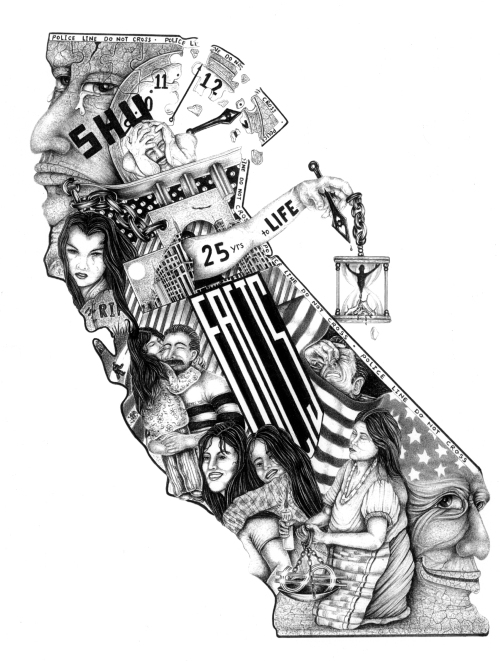
Gabriel Reyes. Like a Hook (Before 2007). 8.5” x 11”, Ball point pen on paper.
As far as I am concerned, any and all mentions of Alyse Emdur’s Prison Landscapes and the Los Angeles Poverty Department’s performances (below) are absolutely essential and cannot be reiterated enough. Each are powerful statements on the nature of power and the over-reach of state control.
LAPD’s dramatisations are informed by the experiences of people who have been incarcerated and Emdur’s collected portraits and large format photos of prison visiting room backdrops originate from a keen engagements with the visual logic of carceral systems.
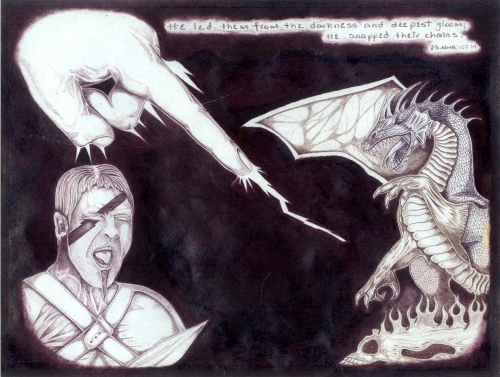
Robert Stockton. Fight (Before 2007): 8.5” x 11”. Pen, additional color.
Prisons and criminal justice reform are gaining attention in the news and public consciousness (a good thing), but just because the conversation is being had and the appetite for a show like Site Unseen might be more ready, the challenging logistics of putting together a curated show of this kind remain unchanged. Kudos to Pinkel for bringing togther artists from inside and outside prison invested in the same goal of making the U.S. a less dangerous, punitive and misunderstood place.
At first glance, the mix of ‘prison art’ on one hand and ‘art made about prisons’ on the other might appear incongruous, but that attitude is exposed as flawed very quickly. As the majority of works in Site Unseen emerge as responses to this country’s brutal, class-dividing prison system, I must conclude that they can do nothing but work together. And so must we if we’re to scale back on decades of fear, bad law and failed policy. If you need resolve and fire-in-your-belly for the task then merely look to the work of those who are subject to confinement. You’ll find it, quietly roaring, there.
